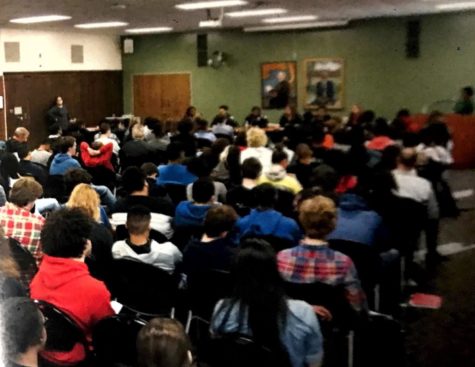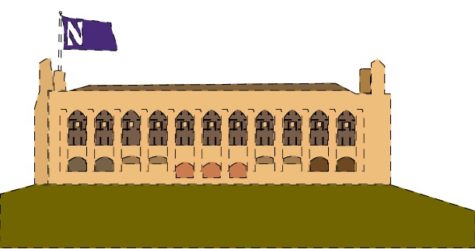Your donation will support the student journalists of the Evanstonian. We are planning a big trip to the Journalism Educators Association conference in Philadelphia in November 2023, and any support will go towards making that trip a reality. Contributions will appear as a charge from SNOSite. Donations are NOT tax-deductible.
Pathway to paradox: how high achievements led to segregated courses
January 28, 2022
Like many schools across the country, ETHS offers a wide variety of classes with a wide range of levels. With over 3,000 students in attendance each year and a student body that comes from a diverse variety of backgrounds, classes are divided into different levels, some deemed higher and more advanced than others. What do these different levels of classes mean to the students and the culture that they create at ETHS?
In 1982, ETHS began teaching an honors-level class that focused on looking at history through the eyes of morality and revealing parts of history like genocide, violence against Native Americans and Japanese internment camps in WWII, which weren’t usually thoroughly discussed in U.S. and World history classes. The class was only offered at an honors level. At the end of the year, ETHS used testing to show that the students in honor-level history classes, like this one, were less prejudiced than regular-level students. They also said that the women in these classes had a higher self-image than women in the regular leveled classes.
This class, like many other aspects about ETHS at this time, served as a symbol of the paradox that has existed at ETHS for decades. In many ways, its hard-hitting curriculum put the school ahead of its times. Students were being exposed to challenging and essential topics and discussions. However, at the same time, a divide between honors students and other students at the school, in terms of the level of education accessible to them—and even self-esteem—became more prevalent.
In 1983, the Chicago Tribune published an article entitled “Black students fall far behind whites, Evanston study finds.” At the time, Black students made up only 13 percent of honors leveled classes and 7.4 percent of Advanced Placement classes.
“Black kids get tracked into lower-level classes as freshmen and have a hard time getting out,” ETHS parent Donald Heyrman said in the 1983 article.
Additionally, Black students were three times more likely to fail a class and half as likely to receive an A or B compared to white students.
Heyrman later went on to say, “Differences in economics, family support for education, and family differences between Black and whites” were partly responsible for these drastic differences in performance and placement between students.
These factors, combined with the difference in accessibility and level of education received in honors and regularly leveled classes created a culture of extreme segregation.
“It was even more segregated than you even think it would be. I mean, it’s almost impossible to describe how segregated it was, and it was how the system was supposed to work. It wasn’t just segregated by race but also class. You have to understand the role that money and access play in that kind of thing,” Cytrynbaum explains.

However, this was a stark contrast to the school-wide academic reports ETHS was releasing. In 1987, the American College Testing (ACT) exam showed that ETHS students scored an average of 20.5, which was higher than the statewide average of 19.1. Additionally, in 1986, ETHS was the third-highest scoring school on Advanced Placement tests out of the entire Midwest region.
At this time, AP classes were beginning to become more prevalent, not just at ETHS, but on a national level. James A. Garfield High school in Los Angeles, which was reported by the Washington Post in 1987 to be full of gangs and violence,” began introducing more AP classes throughout the school. Only 15 percent of its students were enrolled in AP classes, but, by the end of the year, their test scores, overall student performance and even attendance increased. James A. Garfield High School was used as a national example of how AP classes, which offered students the chance to receive college credit, were a necessary factor in motivating students. This became nationally agreed upon by most administrators and teachers, and any worries about student stress levels regarding AP classes and the lack of diversity within them were quickly pushed aside as more test scores across the country increased.
This trend was seen particularly at ETHS. In the same year that James A. Garfield High School was recognized for its introduction of AP classes and the dramatically positive effect they had on their community, ETHS was ranked number five in the country for its AP Calculus program. In 1987, in just the math department alone, they administered 114 AP tests, a significantly higher number than most schools at the time.
By continuing to expand the ways in which ETHS implemented AP and higher level courses, the school directly advanced racial segregation that continued into the ’90s. In 1991, Black students made up 42.4 percent of ETHS’ total student population and white students made up 48.9 percent, but this racial balance was not reflected in the classrooms.
In an article printed by the Chicago Tribune in 1991, District 202’s Dean of Students at the time, Eddie Stevens, said, “The students in honors courses are mostly white, while those in remedial courses are mostly Black. The problem is that Evanston has the same problem that others have. We track students. In that type of system, the rich get richer.”
This tracking is seen even outside of AP and honors classes. ETHS has also offered multiple levels throughout all its curriculums, including varying levels of math. The accelerated math track, which is a prominent feature of ETHS’ math program, begins in elementary schools. Students who qualified for the accelerated math track would “skip a grade” of math, meaning they would learn the content of math classes that were intended for one grade above them. Much like how high school students experienced difficulty straying away from their freshman year tracks, fifth graders not placed in advanced math endured similar challenges.
“[Math tracks are] determined in middle school, so it’s pretty set by the time you get to ETHS,” ETHS Math Department chair Dale Leibforth explains. “[Accelerated math is] determined in fifth grade, so on that track, it is almost guaranteed you will take two years of AP math.”
Evanston/Skokie D65 middle and elementary schools started accelerated math in the late 1960s, after pushes from surrounding states. Historically, students in fifth grade were asked to take a math placement test that would determine their class placement for the remainder of their middle school and high school math career.
“We were testing every single fifth grader,” District 65 Director of STEM David Wartowski says. “Every single fifth grader, not only did they take the standardized [math] test, but we also had them take a written test, which was really difficult intentionally. Very few kids were meant to actually do what was on that test, and there were some unintended consequences of that. When we were writing the tests, and I saw a fifth grader’s answers [where] the student wrote nothing but ‘I don’t know. I’m stupid,’ [it was so difficult]. I can tell you firsthand, I witnessed many tears from students who were just feeling like they were not good enough.”
This system was damaging to the confidence of impressionable elementary students who did not qualify for the accelerated math program, despite these students being in the vast majority.
“Historically less than 1% of students in our district skip a grade of math. While the decision to skip is based on a battery of tests, our data indicate that students who skip typically post MAP scores at the 99th percentile several times in a row,” the District 65 website reads.
MAP stands for the Measures of Academic Progress, which was a series of testing administered to D65 students from second to eighth grade. Although MAP testing did not influence a student’s qualification for accelerated math, the students who were placed in the accelerated track typically performed well on these tests. With accelerated math being accessible to only a small portion of students, it noticably creates harmful, discriminatory trends.
“[The accelerated program] has historically not been very open to all students,” says Leibforth. “It tends to be very white. I think some of the changes [being made now] are trying to get how we can make it more equitable. It’s not as diverse as we want it to be, yet.”
To tackle some of the segregation that occurs within these accelerated courses, D65 terminated the fifth grade testing that determined the placement of accelerated tracks and stemmed insecurities in students from an early age.
“For purposes of placement, every single child is taking the grade-level math,” Wartowski explains.
ETHS is also taking a more inclusive approach to restructuring their math department and is promising new Pathway to Honors classes in order to help all students succeed at the highest possible level. Leibforth describes that going into the 2022-2023 school year, 2 Algebra and Pre-Calculus, classes that had previously been split by honors and regular, will be offered as Pathway to Honors classes.
“Now, [all students are] going to be together instead of having one [honors] group of students be successful,” Leibforth explains. “[All students] have a better opportunity because they’re getting exposed to the more challenging work on the [new] pathway than they were before.”
As administrators continue to strive for equity in all higher level classes, they remind themselves of the importance of opening classrooms to every student. Although their work to accomplish this has come with obstacles, Witherspoon shares that every student has benefited as a result.
“We are better off today than we were [before detracking]. I believe that just being in classes together [helps]. Once you get into [an untracked system], you might have more white kids in one class or more kids of color in another, because of their interests in the course, but not because they’re locked out of a course,” he explains. “I believe, no matter what grade you get in that class, you will benefit for a lifetime by being in a class with multiple perspectives.”




